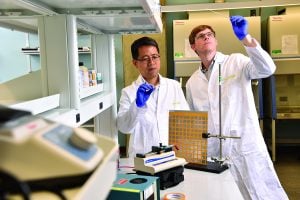A Solution Born of Cross-Talk

“When I came to Hopkins as a young faculty member about 15 years ago, the engineering school was limiting the number of provisional applications that could be filed each year; only very few disclosures moved to the filing stage,” recalls Materials Science and Engineering Professor Hai-Quan Mao. “Back then, success was primarily measured in how many papers you published and whether your peers recognized them as meaningful contributions,” he says. “Nobody really cared if you had a patent filed or not.”
Those days are long gone. The Whiting School in 2013 opened the university’s first business accelerator in the basement of the Stieff Silver Building, which it purchased in November.
Johns Hopkins then hired entrepreneur and investor Christy Wyskiel as a senior adviser to President Ronald J. Daniels. By August 2013, Daniels and School of Medicine Dean Paul B. Rothman formed the faculty-led Committee on the Innovation Ecosystem that, in 2014, concluded that the university and medical school needed to strengthen their commitment to innovation by providing space, funding, and services. Johns Hopkins anted up with a pledge of $40 million in new innovation initiatives over five years.
Since the first accelerator opened, startups based on Johns Hopkins technologies have raised more than $1.2 billion in follow-on funding. And over that same period, Johns Hopkins Technology Ventures has facilitated the creation of 85 startups, generated $145.1 million in licensing revenue, and received 2,887 invention disclosures.
One of the most promising of those new ventures, LifeSprout LLC, was founded by Mao and others in 2015 and is housed at FastForward 1812. It is based on research into human tissue growth using a biomimetic material developed by Mao.
LifeSprout LLC was one of the first recipients of early-stage innovation funds provided by Johns Hopkins “to link basic scientists with clinical partners,” says Mao, referring to several new initiatives including the Johns Hopkins Coulter Translational Partnership, Cohen Translational Engineering Fund, and Louis B. Thalheimer Fund for Translational Research. The Abell Foundation and TEDCO also pitched in funds, bringing the seed investment to $1 million.
“The requirements,” Mao explains, “are that your work has to be translation-focused, and it has to be able to survive in the business world. You can build a flying bicycle in theory in your lab, but if no one knows how to build it and use it in the real world, then what use is it?”
LifeSprout’s product is a unique—and patent-pending—regenerative composite matrix of biodegradable nanofibers integrated in a natural sugar hydrogel. It can be used as space-fillers in a wound or at a surgical site.
“We developed the first fully synthetic and off-the-shelf material that mimics the architecture and function of the natural matrix surrounding the cells in the soft tissue. We ask this biomimetic substance to hold the space and promote the surrounding tissue to grow in,” Mao explains. The hydrogel and nanofibers then degrade harmlessly into the body, eliminating the need to insert—and later remove—plastic or silicone implants.
The genesis for LifeSprout came when Johns Hopkins Medicine clinicians and company co-founders Justin Sacks and Sashank Reddy came to Mao, looking for soft tissue reconstruction solutions after surgery.
“The old approach would have been that if I had an idea, I developed it in my lab and then went out to see if anybody could use it. At the same time, there would be people like Sacks and Reddy who were identifying unmet clinical needs. But it would be difficult for them to invent or design solutions. Now, the conversation is, ‘If you make it, I will definitely use it, and here are the requirements.’ This cross-talk is what makes Hopkins special.”
Mao’s founding team at LifeSprout was rounded out with Silicon Valley transplant Russell Martin, who graduated from Stanford University with a bachelor’s in chemical engineering, and then came east to study under Mao, earning his PhD in materials science and engineering at Johns Hopkins in 2015. He had gotten his feet wet working for two West Coast startups. “I was thinking I would go back to that California biotech startup world after graduate school—that was the default path—but the biomed scene at Hopkins was really a huge draw.” Martin recently purchased a house in Baltimore.
Because the LifeSprout matrix encourages host-tissue ingrowth including blood vessel infiltration, the team is planning ahead to spin off other products such as stem cell delivery and drug delivery composites.
In this new ecosystem of discovery, disclosure, and capital investment, the pressures to produce something provably useful now—to get it right the first time—are vastly different from what they were just 10 years ago.
“As a scientist, I can take my time,” says Mao. “But once people start giving you money, they’re watching you by the hour. If there’s no time for sleep, you don’t sleep.”




